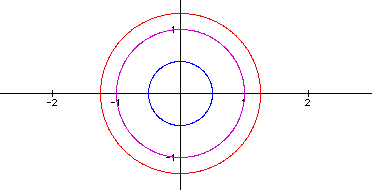
In this write-up I will explore some of the results from varying coefficients and powers of certain parametric equations. In my view, these investigations provide some lovely pictures and some interesting mathematics!
I. Varying values of a and b in the equations
x = a cos(t)
y = b sin(t)
II. Varying values of a and b in the equations
x = cos(at)
y = sin(bt)
III. Varying powers cosine and sine in the equations
x = a cos(t)
y = b sin(t)
I. Varying values of a and b in the equations
x = a cos(t)
y = b sin(t)
In this situation, vary the coefficients of the trigonometric functions themselves. This exploration may be familiar to you already. If a = b, and t runs from 0 to 2p...

The graphs will be circles centered at the origin with radius a. Why? Notice that x^2 + y^2 = a^2(cos(t))^2 + a^2(sin(t))^2 = a^2[(cos(t))^2 + (sin(t))^2] = a^2. And x^2 + y^2 = a^2 is the equation of a circle of radius a centered at the origin.
If a > b, and t runs from 0 to 2p...
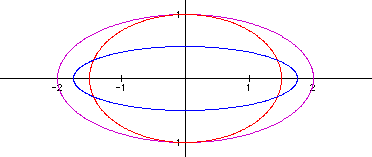
The graphs will be ellipses centered at the origin with horizontal major axis 2a and vertical minor axis 2b. Why? Notice that x^2 = a^2(cos(t))^2 and y^2 = b^2(sin(t))^2, so x^2/a^2 + y^2/b^2 = (cos(t))^2 + (sin(t))^2 = 1.
And, for a > b, x^2/a^2 + y^2/b^2 = 1 is the equation of an ellipse centered at the origin with horizontal major axis 2a and vertical minor axis 2b.
Of course, when a < b, the vertical axis becomes the major axis and the horizontal becomes the minor axis:
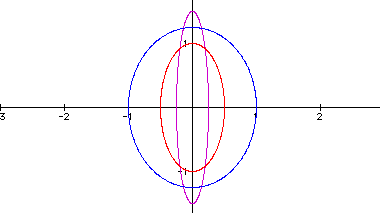
II. Varying values of a and b in the equations of
x = cos(at)
y = sin(bt)
Varying the coefficients of t produces more intriguing results than those above (in this writer's opinion.) Below are some graphs where a varies from 0.5 to 1.5 to 2 and b = 1, while t runs from 0 to 2p.
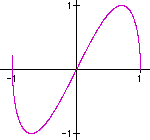


Of course, it would be natural to investigate whether the curves above ever "close," since when a = 1, for instance, the graph is a closed curve (a circle; see above.) So, let t run from 0 to 4p, with these results for a = 0.5, a = 1.5, and a = 2, with b =1:
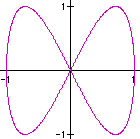
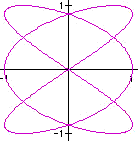

Notice that the curves do close for a = 0.5 and a =1.5, but not for a = 2; the graph appears to be oscillating along the curve for a = 2.
To explore further, download this Graphing Calculator File.
Now consider varying b and letting a = 1.
Below are the graphs where b varies from 0.5 to 1.5 to 2 and a = 1, while t runs from 0 to 2p.
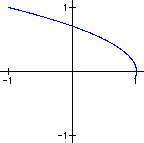
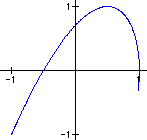

Certainly they do not match the graphs above, but interestingly, the graph when b = 2 (and a = 1) matches the (purple) graph from above when a = 0.5 (and b = 1) for t from 0 to 4p.
When the range of t is expanded to run from 0 to 4p, notice that the graph when b = 0.5 (and a = 1) for t from 0 to 4p matches the (purple) graph above when a = 2 (and b = 1.)

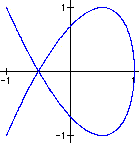
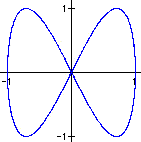
Now consider the graphs where b is positive integer (and a = 1.) Of course, when b = 1, the graph is a circle as seen in part I.--i.e. one "loop." Directly above on the right, when b = 2, the graph contains 2 loops. Below are the graphs for b = 3, 4, and 5 (and a = 1.)
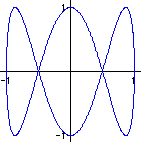

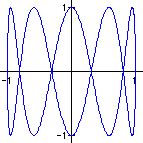
It appears that the number of loops in the graph is the same as the value of b. In addition, as the value of b increases, the graph appears to "fill up" the square with side 2 (from -1 to 1.)
To see this "filling up" and to explore further, download this Graphing Calculator File. This time, the values of the slider variable n are the values of b. (See instructions above as necessary.)
III. Varying powers of cosine and sine in the equations
x = a cos(t)
y = b sin(t)
Building off of part I., here's an exploration of what happens to the graphs of
x = a (cos(t))^n
y = a (sin(t))^nfrom t = 0 to 2p.
Note that if b does not equal a, then the graph will be stretched or compressed in the horizontal and/or vertical directions.
Below is a graph of a = b = 2 as the powers (n) of the trigonometric functions vary from 1 to 6. The purple graph is the familiar circle, when n = 1; the colors of the graphs then correspond to n = 2, 3, 4, 5, 6.
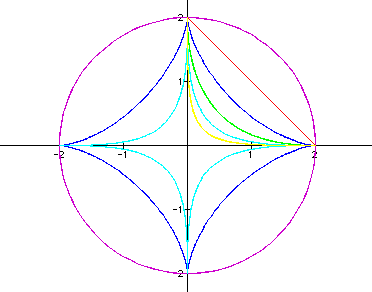
Notice that even powers seem to produce graphs only in the first quadrant, while odd powers produce a graph in four quadrants. (This observation is true even if t is expanded to run from 0 to larger multiplies of p.)
To explore further, this Graphing Calculator file will produce the figure above and allow you to change values for a, b, and t.
To produce a graph with an even power (even value of n) which repeats in all four quadrants, reflections can be used. In the graph below, four sets of equations have been used, with t running from 0 to 2p. For the red graph, a = b = 1; for the purple graph a = -1 and b = 1; for the blue graph, a = b = -1; and for the green graph, a = 1 and b = -1.
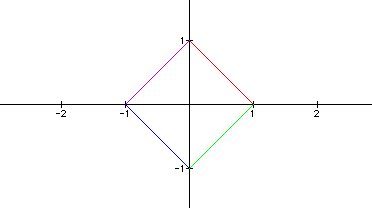
This Graphing Calculator file will allow you to watch the graph of
x = a (cos(t))^n
y = a (sin(t))^n
change when the power n is a sliding variable; you will see that the graph exists in all four quadrants only at the odd integers (i.e., for most values of n, the graph appears to exist only in the first quadrant.) Remember to click ONCE on the arrow button next to the "n" to start the animation.